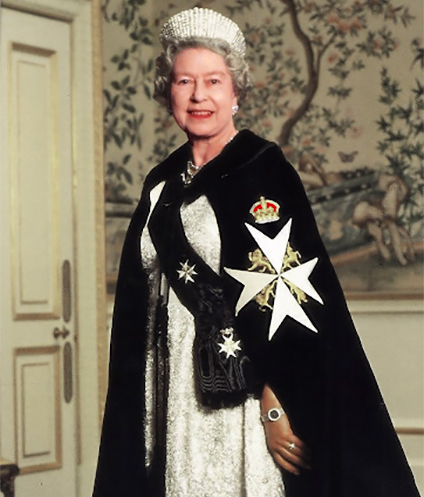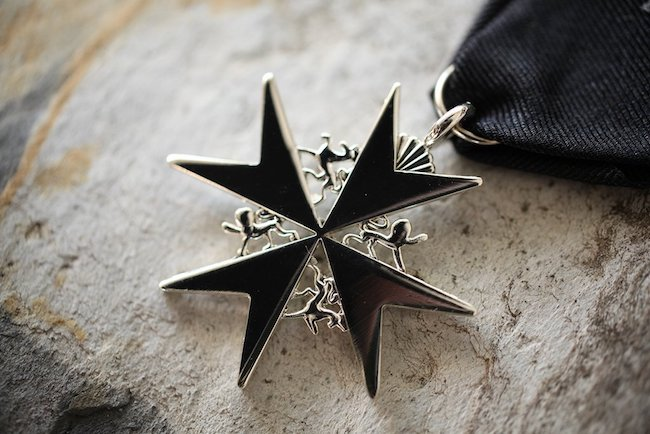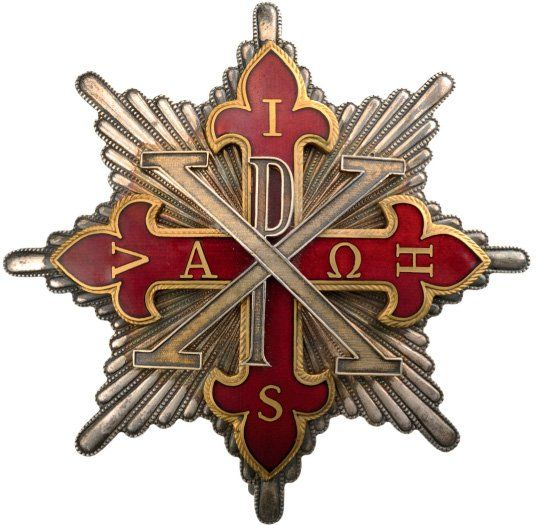A number of recognized¹ European chivalric orders of knighthood and merit have become active and known in the United States this past century. These historically lay religious Christian organizations reflect a code of courage and courtesy and many have their roots in the medieval crusades in the Holy Land. Traditionally, they were under the protection of either a sovereign royal family or the Papacy.
The oldest of these orders is the one dedicated in the name of St. John (the Baptist). Since the Year 1099, it has operated hospitals and for its first seven hundred years fought the Muslim occupiers, primarily led by Turks, in the Holy Land and in the Mediterranean. Later known as the Knights of Rhodes, it is now known as the Sovereign Military Order of Malta, headquartered on the Via Condotti, at the foot of the Spanish Steps, in Rome, Italy. Membership is entirely Roman Catholic and one of the highest lay honors a Catholic may receive. In the United States, there are three associations of the Order of Malta numbering in total about 3,500 members. The oldest of the three is the American Association founded in 1926 and headquartered in New York City. The second oldest association in the United States is the Western Association, founded in 1953 in San Francisco and drawing its members from the Western states. The youngest association is the Federal Association, founded in 1974 in Washington, D.C.

The Equestrian Order of the Holy Sepulchre is, like the Order of Malta, an institution limited to Roman Catholics. Together with the Papal Orders of Merit, these two Orders are the only chivalric orders currently recognized by the Vatican. Members of the Order of the Holy Sepulchre are assigned to Lieutenancies, the original one being the Eastern Lieutenancy, headquartered in New York City. Currently, there are nine Lieutenancies in the United States with a total membership of about 10,000. The Order principally supports Christian activities in the Holy Land.
As a sovereign state, the Holy See awards five orders of knighthood and three orders of merit. These orders do not spring from the pope as Bishop of Rome but as the reigning sovereign of the Holy See. The two papal orders of knighthood most commonly awarded to United States citizens are the Order of St. Gregory the Great, founded in 1831, and the Order of St. Sylvester Pope and Martyr, founded in 1841, both of which are open to non-Catholics, as they are awards of a sovereign government.
There are an additional three principal European chivalric orders with a presence in the United States and which are recognized as legitimate by such arbiters of the hereditary claims of European aristocracy as the Almanach de Gotha. That publication has been the chronicle of European royal and noble families since 1763. The dynastic chivalric Orders active in the United States include two orders under separate Italian Royal dynasties, and the Royal Portuguese Orders. They are the historically Italian Constantinian Order, the Order of Sts. Maurice and Lazarus, as well as the Portuguese dynastic orders. All of which reflect prestigious alternatives to the Order of Malta, the St. John Orders, and the Order of the Holy Sepulchre.
A primarily non-Catholic order of chivalry, the Venerable Order of St. John was chartered by Queen Victoria of Great Britain in 1888 in the tradition of the crusading Order of St. John. Its sovereign head today is King Charles III and originally it primarily consisted of Anglicans. It is now ecumenical and has members of many denominations and faiths. An American Society was formed in 1958 by members residing in the U.S., including Bishop Horace Donegan of New York, Douglas Fairbanks Jr., Winthrop W. Aldrich, Samuel W. Meek and Grayson L. Kirk. Early members were Angier Biddle Duke, Mrs. Vincent Astor, The Rev. Canon Edward N. West, OBE, Mrs. William Randolph Hearst, Sr. and Mrs. Thomas Vietor. The Society became a Priory in 1996 led by a Prior. The principal object of The Priory in the USA is to raise funds for the Order’s Ophthalmic Hospital in Jerusalem. The members meet in the Fall for an annual investiture, held at an Episcopal Cathedral or in a historic church in the United States.

Joined in a formal alliance with the Venerable Order of St. John is the German-based Bailiwick of Brandenburg of the Order of St. John, otherwise known as the Johanniter Order, along with the Dutch and Swedish Johanniter Orders. The Dutch and Swedish Orders obtained autonomy from the German Johanniter in 1946. The Bailiwick of Brandenburg of the Order of St. John, was originally part of the Order of Malta in the area of Northern Germany called Brandenburg (later Prussia). The Bailiwick accepted the Reformation in the Sixteenth Century. That branch of the Order of St. John has had a continued presence in the United States since 1883. However, until the 1960’s, that presence primarily consisted of European diplomats or displaced European aristocrats. The formal requirement that members must be of the nobility was dropped by the Johanniter in 1948, although it remains exclusively Protestant and male. In 2022, the majority of the seventy-three members in the United States and the twenty-six members in Canada have German or Hungarian family origins.

The Sacred Military Constantinian Order of St. George is a strictly Catholic order established in Italy by 1570. In 1699 it became a dynastic order of what would later be the Bourbon Two Sicilies Royal Family. It currently has two claimants, each of whom has their own adherents. An American association was established in 1979 of members of the followers of the Italian Duke of Castro. It is commonly referred to as the Neopolitan branch. It now has approximately fifty members in North America (the Order of Francis I is a junior order of merit also headed by the Duke of Castro and is open to non-Catholics). The other branch of the Constantinian Order is often referred to as the Spanish branch, as it holds allegiance to the Duke of Calabria who resides in Madrid, Spain. This branch of the Constantinian Order also has about fifty members in the United States.
Pope Gregory XIII founded the Italian Catholic chivalric Order of Saints Maurice and Lazarus in 1572. It is an amalgamation of two much older orders originating in the 15th and 12th centuries respectively, the grand mastership of which was conferred upon the House of Savoy. The House of Savoy became the Royal House of Italy with the nineteenth century unification of that country, resulting in the Order becoming an ecumenical Christian state order. After the 1946 proclamation of the Republic of Italy, the royal family went into exile but retained the Grand Mastership of its orders. It and a civil non-religious Order, the Order of Merit of Savoy, originally founded in 1830, have approximately 175 knights and dames in North America. Mr. James C. Risk was appointed the first delegate in 1988 and was succeeded by Mr. Carl. J. Morelli in 1997, and Mr. Joseph Sciame in 2022.
The American Association of Knights & Dames of the Royal House of Portugal is the organized presence in the U.S. of the Portuguese Royal House under its head, Dom Duarte, the Duke of Braganza. The House awards the Order of St. Michael of the Wing and the Royal House Order. In addition, its highest ranking honor, the Order of Vila Viçosa, is given sparingly. LTC Steve Besinaiz is the President of the American Association.
The Teutonic Order, which was founded in 1190 as a field hospital by German-speaking pilgrims from Luebeck and Bremen, became an order of knighthood in 1198. It was recognized as such by Pope Innocent III on 19 February 1199. With the fall of the Habsburg Austro-Hungarian Empire, it became a religious order on 27 November 1929. This non-dynastic Order consists of Catholic religious (brothers and sisters), oblates (religious without vows), and spiritual associates (lay or clerical) called familiars. At this time the Order is considered a quasi-chivalric organization as the actual members remain limited to Catholic religious clergy and lay persons. Very few of the members and familiars of the Order reside outside Europe, with only three residing in the United States in the year 2023.
Together these recognized chivalric orders of knighthood and merit simultaneously are emblematic and one of the last vestiges of all that has made for the greatness, strength, and charm of aristocratic Europe down through the centuries, including most importantly its Christian faith.
by Robert M. Clark, Esq., HSC Patron²
¹ Unrecognized orders are those organizations founded by private initiative which appropriate the names of former or deceptively similar authentic chivalric orders without the authorization of the founding states or royal families.
² MBA, JD; Knight of Justice, Order of St. John (Johanniter); Grand Cross, Order Of Christ (Brazil, Imperial House of Orleans-Braganza); Knight Commander, Order of Sts. Maurice & Lazarus; Knight Commander, Order of Vila Viçosa; Knight Commander, Order of Francis I; Hereditary Member, Society of the Cincinnati; and National President 2020-22, Aztec Club of 1847.